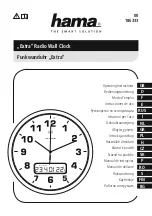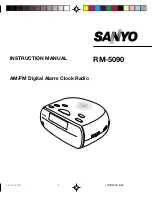
Clock calibration
M41T00AUD
24/44
6 Clock
calibration
The M41T00AUD oscillator is designed for use with a 12.5pF crystal load capacitance. With
a nominal ±20 ppm crystal, the M41T00AUD will be accurate to ±35 ppm. When the
calibration circuit is properly employed, accuracy improves to better than ±2 ppm at 25°C.
The M41T00AUD design provides the following method for clock error correction.
6.1
Digital calibration (periodic counter correction)
This method employs the use of periodic counter correction by adjusting the number of
cycles of the internal 512Hz signal counted in a second. By adding an extra cycle, for 513,
a long second is counted for slowing the clock. By reducing it to 511 cycles, a short second
is counted for speeding up the clock.
Not every second is affected. The calibration value (bits D4-D0 of register 07h) and its sign
bit (D5 of same register) control how often a short or long second is generated.
The basic nature of a 32KHz crystal is to slow down at temperatures above and below 25°C.
Whether the temperature is above or below 25°C, the device will tend to run slow.
Therefore, most corrections will need to speed the clock up. Hence, the M41T00AUD
calibration circuit uses a non-symmetric calibration scheme. Positive values, for speeding
the clock up, have more effect than negative values, for slowing it down. A positive value
will speed the clock up by approximately 4ppm per step. A negative value will slow it by
approximately 2ppm per step.
In the M41T00AUD's calibration circuit, positive correction is applied every 8
th
minute
whereas negative correction is applied every 16
th
minute. Because positive correction is
applied twice as often, it has twice the effect for a given calibration number, N. When the
calibration sign bit is positive, N seconds of every 8
th
minute will be shortened to 511 cycles
of the 512Hz clock. When the calibration sign bit is negative, N seconds of every 16
th
minute will be lengthened to 513 cycles of the 512Hz clock.
When N is positive, one minute will have N seconds which are 511 cycles and the remaining
seconds will be 512 cycles. The next seven minutes are nominal with all seconds 512
cycles each.
Example 1:
Sign is 1 and N is 2 (00010b)
The 8-minute interval will be:
2 * 511 + (60-2) * 512 + 7 * 60 * 512 = 245758 cycles long out of a possible
512 * 60 * 8 = 245760 cycles of the 512Hz clock in an 8-minute span.
This gives a net correction of (245760-245758) / 245760 = -8.138ppm
When N is negative, one minute will have N seconds which are 513 cycles and the
remaining seconds will be 512 cycles. The next 15 minutes are nominal with all seconds
512 cycles each
















































